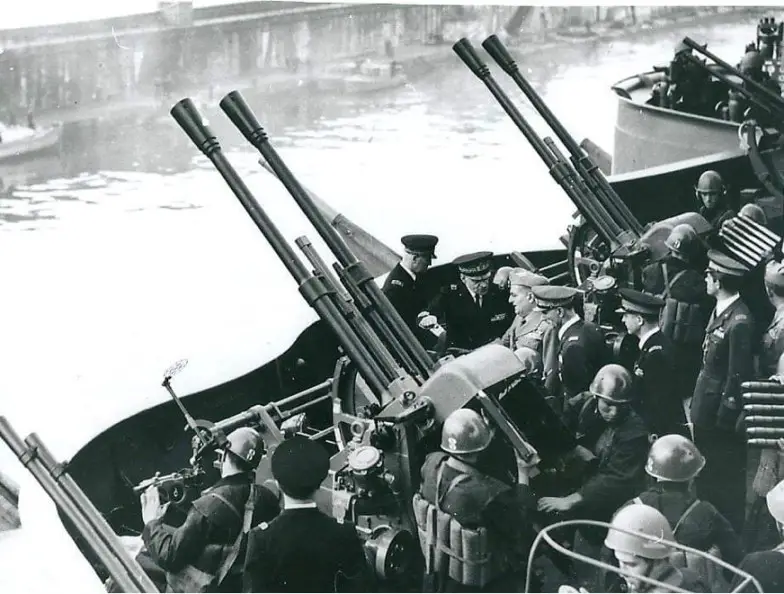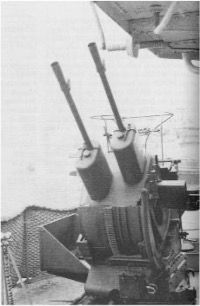During World War Two, the Italian navy utilized various types of anti-aircraft guns of all calibers. This article provides an overview of all these weapons.
The 100/47 AA, OTO

Figure 1 The 100/47 OTO
One of the most iconic gun mounts and perhaps one of the most widespread, was the 100/47 gun produced by OTO, available in the models 1924, 1927 and 1928. This gun was a de facto replica of the Austro-Hungarian 10cm/50 model 1910 produced by Skoda. The Italians had seized several vessels from the former K.u.K. Navy, such as Tatra class destroyers and the Saida scout cruiser, all equipped with the 10cm Skoda guns. These guns had impressed the Italians, and the navy ordered the replication of such weapons.
In the 1920s they formed the heavy AA (and secondary) armament of the Trento class cruisers and later equipped virtually all Italian cruisers built in the interwar years. Their distinctive twin mount allowed an elevation range of -5°/+85° and the rate of fire was approximately 8-10 rounds per minute. The ammunition weighed 26kg with the projectile only being approximately 14kg. The official range was 15km (45°) and 8-9 km (AA ceiling).
Turning and elevation were powered by an electric engine, but these movements were too slow, decreasing the overall effectiveness of the gun AA fire, thus being more adequate for AA barrage fire.
The model 1928 was the most widespread on Italian cruisers and rebuilt battleships of the Cavour class, while later models in single mounts equipped smaller vessels for just anti-ship purposes.
The 90/50 AA, Ansaldo – OTO
The 90/50 Ansaldo gun model 1939, was developed in the 1930s to serve as the new main anti-aircraft gun on Italian battleships and cruisers. These guns equipped the brand new Littorio class battleships and also the rebuilt Duilio and Andrea Doria. In theory, they would have equipped the next generation of Italian light cruisers (the Ciano class) but this never went beyond the design phase.

Figure 2 90mm guns of battleship Littorio
The gun mount was fully shielded to provide maximum protection for the crew, especially from the blasts of the main 381mm guns. Each mount was placed on a barbette on the ship’s deck, the barbette housed the stabilization system, a peculiarity of these guns.
The purpose of the stabilization system was to improve the aiming and firing of the guns, by countering the rolling and swinging that characterize ships on the move. There was a wide array of mechanical gears, propelled by small electric engines to make the whole thing work.
However, the system was quite delicate and proved to be perhaps too advanced for the time, in addition, waterproofness was lacking and thus infiltrations caused several issue malfunctions so that the system was often disabled.
The gun had an elevation range of -3°/+75°, rate of fire was around 12 rounds per minute, 1 every 5 seconds, this one could have been higher if the stabilization system had worked properly. The official range was 10 km (45°) and 8-9km (AA ceiling)
The ammunition weighed 18kg with the actual projectile around 10kg. Upon exploding, the shells fragmented into very small pieces which could negatively affect the damage inflicted on the target aircraft.
The 90mm guns were therefore mainly used to create anti-aircraft barrages, to keep the attacking aircraft at bay, if necessary they could also be used for shooting against light ships.
From the 90/50 naval gun, the Ansaldo factory derived the 90/53 gun that equipped anti-aircraft units of the Italian army. The gun also proved to be an excellent anti-tank weapon, considered equal to the German Flak 88. This type of gun equipped the few Semoventi 90/53 built between 1942 and 1943.
The 37/54 Breda
The 37mm Breda gun was a close-range AA weapon, that could be found on all battleships, cruisers and even some destroyers. It existed in the twin mount model (M1932 and M1938) and in the single collapsible mount (M1939).
The widely used M1938 was air-cooled and gas-operated, with a flat vertical magazine holding six rounds which could be continuously fed by the gun crew.

Figure 3 37mm guns of a Littorio class battleship
The elevation range was -10°/+80° for the twin mounts and -5°/+90° for the single ones, with the (practical) rate of fire of 140 shots per minute, while each shell weighed around 1.6kg. The official range was 7,800 meters (45°) and 5,000 (AA ceiling). Train and elevation were manual only.
The main defect of these guns was that the twin mount, with its recoil, caused severe vibrations to the lower supporting structure which in turn made the aiming more difficult.
The 20/65 Breda
The 20mm Breda gun Model 1935 was another close-range AA weapon, widely adopted on destroyers and battleships. During wartime, these guns were mounted also on cruisers, replacing the less effective 13,2 mm machine guns.
As for the Breda 37/54, the 20/65 was an air-cooled, gas-operated weapon, available in twin and single mounts. Ammunitions were fed in via flat magazines with 12 rounds each.

Figure 4 Breda 20/65 gun
The elevation range was -10°/+100°, the (practical) rate of fire of 120-150 shots per minute, while each shell weighed around 0.32kg. The practical range was 2,500 meters (45°) and 2,900 (AA ceiling). Train and elevation were manual only.
The 20/65 also suffered from the excessive vibrations caused by the twin mount but it was considered an effective close-range weapon which kept expanding its presence on all warships.
For instance, battleship Vittorio Veneto began the war with 16×20/65 and by 1942 these had increased to 32.
The Breda Mod.31
This machine gun was derived from the French Hotchkiss M1929 and was widely adopted by the Regia Marina, especially on submarines, destroyers and cruisers. The machine gun was air-cooled and fed by a vertical magazine containing 30 rounds, capable of 400 shots per minute, its effective range was 2,000 meters

Figure 5 A Breda M31 mounted on a submarine
Aircraft evolution and their increased level of threat meant that these low-calibre weapons were slowly replaced, where possible, on all types of surface ships, with the heavier Breda 20/65.
Sources
Campbell, J. (1985). Naval weapons of World War Two.
Bagnasco, E., & De Toro, A. (2020). Le corazzate delle classi Conte di Cavour e Duilio (1911-1956).
Bagnasco, E., & De Toro, A. (2020). Le navi da battaglia classe “Littorio” 1937-1948. Roma: Ufficio storico della Marina Militare.
Website Naval Weapons: http://www.navweaps.com/